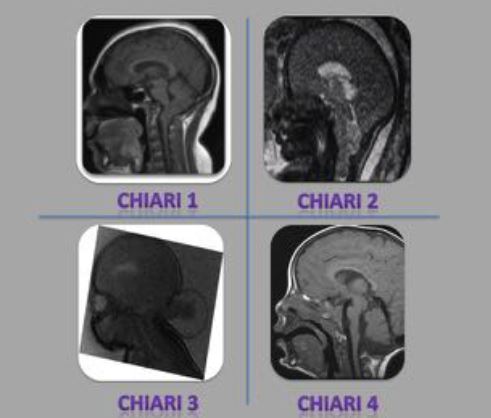CHIARI DE 0 A 4, ¿CÓMO PODEMOS AYUDAR LOS RADIÓLOGOS?
Palabras clave:
CHIARI, poster, seramResumen
Objetivos Docentes
1. Revisar el espectro de patologías muy diferentes entre sí recogidas bajo el nombre de malformación de Chiari, que incluye desde anomalías en el flujo del líquido cefalorraquídeo (LCR) sin alteración estructural asociada hasta malformaciones cerebro-espinales muy complejas.
2. Exponer la clasificación actual e ilustrar el valor de las pruebas de imagen avanzada en el manejo de estos pacientes.
Revisión del tema
- Introducción
Pese a que se describió por primera vez a finales del siglo XIX [1], la malformación de Chiari esa una patología que permanece de actualidad (más de 250 publicaciones nuevas desde 2014).
Bajo el nombre de anomalía de Chiari se recoge un amplio espectro de patologías que históricamente se han agrupado aunque sus manifestaciones clínicas y su abordaje terapéutico son muy diferentes. Se trata de una enfermedad generalmente congénita, en la que existe una alteración anatómica de la base del cráneo, con una herniación de parte del cerebelo y del tronco del encéfalo a través del foramen magno hacia el canal cervical.
Descargas
Citas
Pearce J. Arnold Chiari, or “Cruveilhier Cleland Chiari” malformation. Journal of Neurology, Neurosurgery, and Psychiatry. 2000;68(1):13
Sahuquillo J, Poca MA. Actualizaciones en el tratamiento quirúrgico de la malformación de Chiari tipo 1 y del complejo Chiari 1/siringomielia. Neurologia 1998; 13: 223-45
Penfield W, Coburn D. Arnold-Chiari malformation and its operative treatment. Arch NeurPsych. 1938;40(2):328-36
Barry A, Patten B, Stewart B. Possible factors in the development of the Arnold-Chiari malformation. J Neurosurg. 1957;14(3):285-301
Nyland H, Krogness KG. Size of posterior fossa in Chiari type 1 malformation in adults. Acta Neurochir (Wien). 1978;40(3-4):233-42
Marin-Padilla M. Morphogenesis of experimentally induced Arnold--Chiari malformation. J Neurol Sci. 1981;50(1):29-55
Chiapparini L, Saletti V, Solero CL, Bruzzone MG, Valentini LG. Neuroradiological diagnosis of Chiari malformations. Neurol. Sci. 2011;32 Suppl 3 (S3): S283-6
Tubbs RS, Muhleman M, Loukas M, Oakes WJ. A new form of herniation: the Chiari V malformation. Child's Nervous System. 2012; 2:305-7
Elster AD, Chen MY. Chiari I malformations: clinical and radiologic reappraisal. Radiology. 1992;183(2):347-53
Shah S, Haughton V, Muñoz del Río A. CSF flow through the upper cervical spinal canal in Chiari I malformation. Am J Neuroradiol 2011; 32:1149-53
Haughton VM, Korosec FR, Medow JE, Dolar MT, Iskandar BJ. Peak systolic and diastolic CSF velocity in the foramen magnum in adult patients with Chiari I malformations and in normal control participants. Am J Neuroradiol 2003; 24:169-76
Hofkes SK, Iskandar BJ, Turski PA, Gentry LR, McCue JB, Haughton VM. Differentiation between symptomatic Chiari I malformation and asymptomatic tonsilar ectopia by using
cerebrospinal fluid flow imaging: initial estimate of imaging accuracy. Radiology. 2007 Nov;245(2):532-40
Krueger KD, Haughton VM, Hetzel S. Peak CSF velocities in patients with symptomatic and asymptomatic Chiari I malformation. Am J Neuroradiol 2010; 31:1837-41
Tubbs R, Oakes J. The Chiari malformations. Springer Ed. 2013.
Ucar M, Tokgoz N, Koc AM, Kilic K, Borcek AO, Oner AY, et al. Assessment of 3D T2-weighted high-sampling-efficiency technique (SPACE) for detection of cerebellar tonsillar
motion: new useful sign for Chiari I malformation. Clin Imaging. 2015;39(1):42-50
Glenn O, Barkovich J. Magnetic resonance imaging of the fetal brain and spine: an increasingly important tool in prenatal diagnosis: part 2. AJNR 2006; 2:1807-14
Adzick NS, Thom EA, Spong CY, Brock JW, Burrows PK, Johnson MP, et al. A randomized trial of prenatal versus postnatal repair of myelomeningocele. N Engl J Med 2011; 364:993-1004


